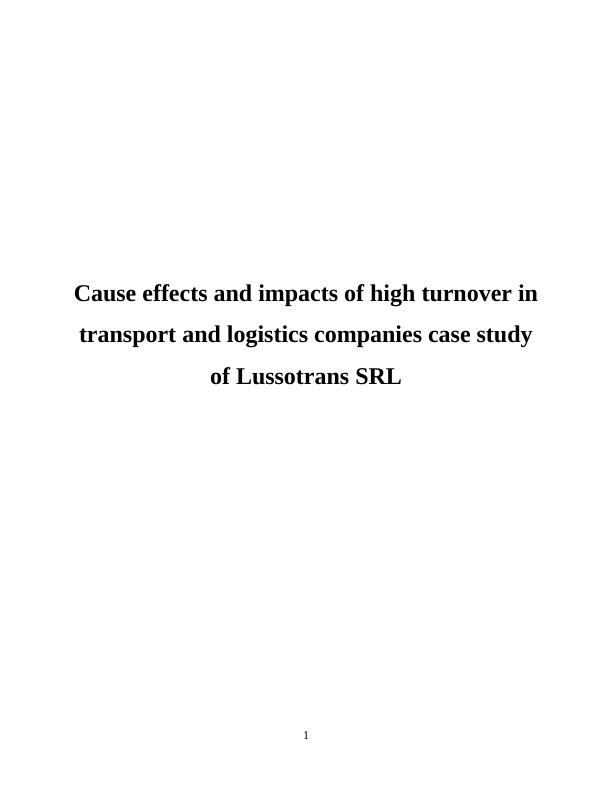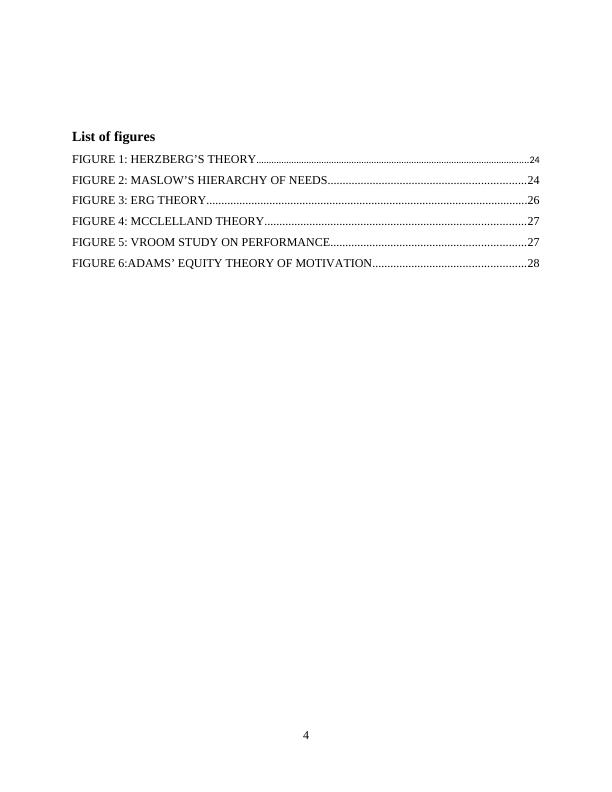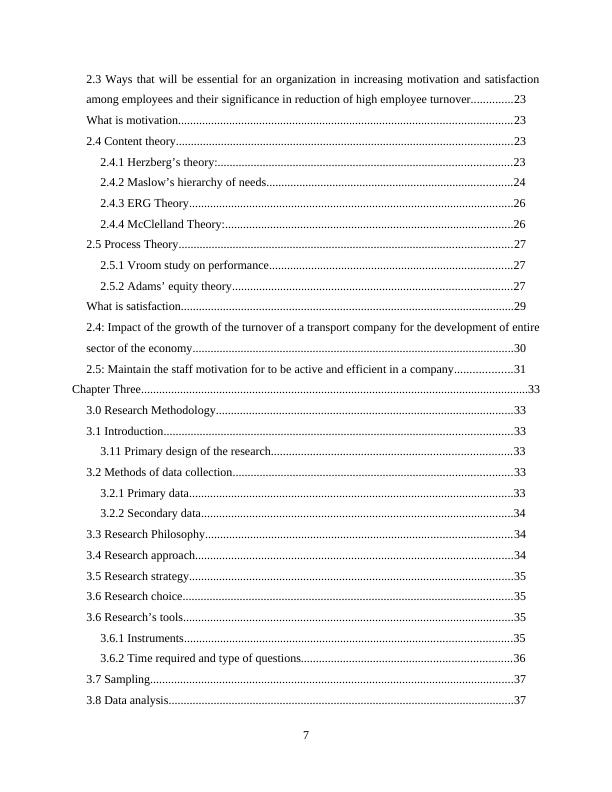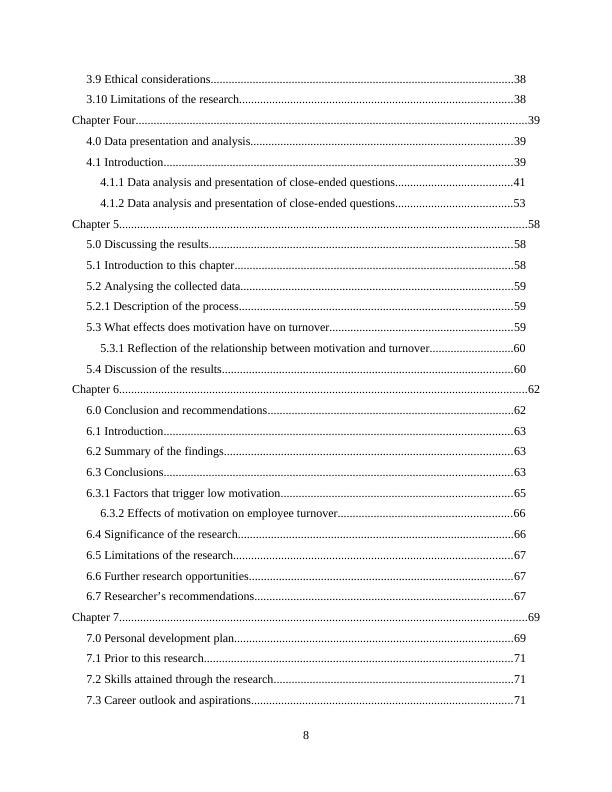Cause effects and impacts of high turnover in transport and logistics companies
78 Pages24185 Words66 Views
Added on 2023-01-04
About This Document
This dissertation aims to identify the existing barriers and needs and propose strategies in employee management for the economic development of transport and logistics companies. It explores the causes, effects, and impacts of high turnover in these companies, with a case study of Lussotrans SRL. The research methodology includes literature review, data collection, and analysis. The findings provide insights into the importance of employee management in enhancing productivity and profitability.
Cause effects and impacts of high turnover in transport and logistics companies
Added on 2023-01-04
ShareRelated Documents
Cause effects and impacts of high turnover in
transport and logistics companies case study
of Lussotrans SRL
1
transport and logistics companies case study
of Lussotrans SRL
1

Abstract
Main purpose of this dissertation is to identify the existing barriers and needs and propose
strategies in employee management for the economic development of the company. This is the
main purpose of conducting this dissertation in a successful manner. There are different activities
used by the researcher for attaining this purpose in a successful manner. The introduction is a
first activity that was done by developing research aim, objectives, and questions as well as
identifying the significance and rationale of the dissertation. A literature review is another
activity or chapter that was completed by using secondary sources such as articles, magazines,
books, journals, and many more. All these are major sources that helped the researcher in
attaining research aim as well as the fulfillment of the research gap.
The research methodology is another activity that was done by using different types of
methodology such as research philosophy, research strategy, research approach, research choice,
sampling, close-ended and open-ended research questions, and many more. All these are main
methods that helped the researcher in the collection as well as evaluation of appropriate data
about the topic. This turn to impact in achieving of aim and each objective of the dissertation
successfully. Data analysis was done for evaluating the qualitative and quantitative information
gathered from interviews and questionnaires. For this, frequency distribution analysis and
thematic analysis were applied as an analytical technique. In this, frequency distribution analysis
helped the researcher in evaluating quantitative information gathered from close-ended
questions. Thematic analysis was applied for evaluating the information collected from open-
ended questions. As both techniques helped the investigator in evaluating qualitative as well as
quantitative information in a systematic or successful manner. Conclusion and recommendations
have been completed by explaining information about the entire activities in a systematic and
clear manner. This helped the investigator in the accomplishment of each objective of the
dissertation in a successful manner.
2
Main purpose of this dissertation is to identify the existing barriers and needs and propose
strategies in employee management for the economic development of the company. This is the
main purpose of conducting this dissertation in a successful manner. There are different activities
used by the researcher for attaining this purpose in a successful manner. The introduction is a
first activity that was done by developing research aim, objectives, and questions as well as
identifying the significance and rationale of the dissertation. A literature review is another
activity or chapter that was completed by using secondary sources such as articles, magazines,
books, journals, and many more. All these are major sources that helped the researcher in
attaining research aim as well as the fulfillment of the research gap.
The research methodology is another activity that was done by using different types of
methodology such as research philosophy, research strategy, research approach, research choice,
sampling, close-ended and open-ended research questions, and many more. All these are main
methods that helped the researcher in the collection as well as evaluation of appropriate data
about the topic. This turn to impact in achieving of aim and each objective of the dissertation
successfully. Data analysis was done for evaluating the qualitative and quantitative information
gathered from interviews and questionnaires. For this, frequency distribution analysis and
thematic analysis were applied as an analytical technique. In this, frequency distribution analysis
helped the researcher in evaluating quantitative information gathered from close-ended
questions. Thematic analysis was applied for evaluating the information collected from open-
ended questions. As both techniques helped the investigator in evaluating qualitative as well as
quantitative information in a systematic or successful manner. Conclusion and recommendations
have been completed by explaining information about the entire activities in a systematic and
clear manner. This helped the investigator in the accomplishment of each objective of the
dissertation in a successful manner.
2

Acknowledgments
Throughout my career path, I faced different challenges, taking from all of them the positive
side and the skills and knowledge that I have today in my experience. This MSc in International
Business Management has been one of the most challenging experiences of my life, as I studied
in Portugal for 15 years, and suddenly I came to the UK and I applied for this master,
challenging myself. I would like to say, firmly, that this master has helped me to go through my
fears and to meet new a very special people. This research wouldn’t have happened without the
support of my husband, family, and friends which I’m deeply thankful for all the support and
patience, as without their support this research and all this experience wouldn’t be the same. I
would like to express my deepest and sincere appreciation for all my lectures, especially to the
module leader, Muhammad Azam, which has been our biggest support and motivator to all of us.
From the start of this master, Muhammad has been sharing with us the most valuable advice and
always showed a profound belief in our work and skills. I cannot begin to express my thanks to
my supervisor, Alessandro Ferrazza, who has supported me from the start, explain with patience
and practical suggestions, which has been the most helpful contribution and advice. For that, and
the knowledge and patience that cannot be underestimated, I couldn’t be more grateful.
Nonetheless, a special thank you to all my colleagues who I will never forget their support,
pieces of advice, and all the useful information that was shared throughout this year of a great
and beautiful experience.
3
Throughout my career path, I faced different challenges, taking from all of them the positive
side and the skills and knowledge that I have today in my experience. This MSc in International
Business Management has been one of the most challenging experiences of my life, as I studied
in Portugal for 15 years, and suddenly I came to the UK and I applied for this master,
challenging myself. I would like to say, firmly, that this master has helped me to go through my
fears and to meet new a very special people. This research wouldn’t have happened without the
support of my husband, family, and friends which I’m deeply thankful for all the support and
patience, as without their support this research and all this experience wouldn’t be the same. I
would like to express my deepest and sincere appreciation for all my lectures, especially to the
module leader, Muhammad Azam, which has been our biggest support and motivator to all of us.
From the start of this master, Muhammad has been sharing with us the most valuable advice and
always showed a profound belief in our work and skills. I cannot begin to express my thanks to
my supervisor, Alessandro Ferrazza, who has supported me from the start, explain with patience
and practical suggestions, which has been the most helpful contribution and advice. For that, and
the knowledge and patience that cannot be underestimated, I couldn’t be more grateful.
Nonetheless, a special thank you to all my colleagues who I will never forget their support,
pieces of advice, and all the useful information that was shared throughout this year of a great
and beautiful experience.
3

List of figures
FIGURE 1: HERZBERG’S THEORY.............................................................................................................24
FIGURE 2: MASLOW’S HIERARCHY OF NEEDS..................................................................24
FIGURE 3: ERG THEORY...........................................................................................................26
FIGURE 4: MCCLELLAND THEORY.......................................................................................27
FIGURE 5: VROOM STUDY ON PERFORMANCE.................................................................27
FIGURE 6:ADAMS’ EQUITY THEORY OF MOTIVATION...................................................28
4
FIGURE 1: HERZBERG’S THEORY.............................................................................................................24
FIGURE 2: MASLOW’S HIERARCHY OF NEEDS..................................................................24
FIGURE 3: ERG THEORY...........................................................................................................26
FIGURE 4: MCCLELLAND THEORY.......................................................................................27
FIGURE 5: VROOM STUDY ON PERFORMANCE.................................................................27
FIGURE 6:ADAMS’ EQUITY THEORY OF MOTIVATION...................................................28
4

List of abbreviations
SRL: Super Religare Laboratories
HRM: Human resource management
PDP: Personal development plan
5
SRL: Super Religare Laboratories
HRM: Human resource management
PDP: Personal development plan
5

Table of Contents
Abstract............................................................................................................................................2
Acknowledgments............................................................................................................................3
List of figures...................................................................................................................................4
List of abbreviations........................................................................................................................5
Table of Contents.............................................................................................................................6
Chapter 1........................................................................................................................................10
1.0 Introduction and Background...............................................................................................10
1.1 Background of company.................................................................................................10
1.2 Research Background.....................................................................................................10
1.3 Problem statement..........................................................................................................12
1.4 Aim and Objectives of the research................................................................................12
1.5 Scope and Importance....................................................................................................13
1.6 The objectives of the research will be............................................................................13
1.7 Questions to be answered in this research......................................................................14
1.8 Project Limitations.........................................................................................................14
1.9 Summary of chapter one.................................................................................................14
1.10 Looking ahead into the next chapters...........................................................................15
Chapter 2........................................................................................................................................17
2.0 Literature review............................................................................................................17
2.1 Introduction to this chapter.............................................................................................17
2.2 Causes that influence the turnover of a transport company along with its impact on human
resource.................................................................................................................................17
2.2 Motivation of the employed staff and the satisfaction of the employees important......21
6
Abstract............................................................................................................................................2
Acknowledgments............................................................................................................................3
List of figures...................................................................................................................................4
List of abbreviations........................................................................................................................5
Table of Contents.............................................................................................................................6
Chapter 1........................................................................................................................................10
1.0 Introduction and Background...............................................................................................10
1.1 Background of company.................................................................................................10
1.2 Research Background.....................................................................................................10
1.3 Problem statement..........................................................................................................12
1.4 Aim and Objectives of the research................................................................................12
1.5 Scope and Importance....................................................................................................13
1.6 The objectives of the research will be............................................................................13
1.7 Questions to be answered in this research......................................................................14
1.8 Project Limitations.........................................................................................................14
1.9 Summary of chapter one.................................................................................................14
1.10 Looking ahead into the next chapters...........................................................................15
Chapter 2........................................................................................................................................17
2.0 Literature review............................................................................................................17
2.1 Introduction to this chapter.............................................................................................17
2.2 Causes that influence the turnover of a transport company along with its impact on human
resource.................................................................................................................................17
2.2 Motivation of the employed staff and the satisfaction of the employees important......21
6

2.3 Ways that will be essential for an organization in increasing motivation and satisfaction
among employees and their significance in reduction of high employee turnover..............23
What is motivation...............................................................................................................23
2.4 Content theory................................................................................................................23
2.4.1 Herzberg’s theory:..................................................................................................23
2.4.2 Maslow’s hierarchy of needs..................................................................................24
2.4.3 ERG Theory............................................................................................................26
2.4.4 McClelland Theory:................................................................................................26
2.5 Process Theory...............................................................................................................27
2.5.1 Vroom study on performance.................................................................................27
2.5.2 Adams’ equity theory.............................................................................................27
What is satisfaction...............................................................................................................29
2.4: Impact of the growth of the turnover of a transport company for the development of entire
sector of the economy...........................................................................................................30
2.5: Maintain the staff motivation for to be active and efficient in a company...................31
Chapter Three.................................................................................................................................33
3.0 Research Methodology...................................................................................................33
3.1 Introduction....................................................................................................................33
3.11 Primary design of the research................................................................................33
3.2 Methods of data collection.............................................................................................33
3.2.1 Primary data............................................................................................................33
3.2.2 Secondary data........................................................................................................34
3.3 Research Philosophy......................................................................................................34
3.4 Research approach..........................................................................................................34
3.5 Research strategy............................................................................................................35
3.6 Research choice..............................................................................................................35
3.6 Research’s tools..............................................................................................................35
3.6.1 Instruments.............................................................................................................35
3.6.2 Time required and type of questions......................................................................36
3.7 Sampling.........................................................................................................................37
3.8 Data analysis...................................................................................................................37
7
among employees and their significance in reduction of high employee turnover..............23
What is motivation...............................................................................................................23
2.4 Content theory................................................................................................................23
2.4.1 Herzberg’s theory:..................................................................................................23
2.4.2 Maslow’s hierarchy of needs..................................................................................24
2.4.3 ERG Theory............................................................................................................26
2.4.4 McClelland Theory:................................................................................................26
2.5 Process Theory...............................................................................................................27
2.5.1 Vroom study on performance.................................................................................27
2.5.2 Adams’ equity theory.............................................................................................27
What is satisfaction...............................................................................................................29
2.4: Impact of the growth of the turnover of a transport company for the development of entire
sector of the economy...........................................................................................................30
2.5: Maintain the staff motivation for to be active and efficient in a company...................31
Chapter Three.................................................................................................................................33
3.0 Research Methodology...................................................................................................33
3.1 Introduction....................................................................................................................33
3.11 Primary design of the research................................................................................33
3.2 Methods of data collection.............................................................................................33
3.2.1 Primary data............................................................................................................33
3.2.2 Secondary data........................................................................................................34
3.3 Research Philosophy......................................................................................................34
3.4 Research approach..........................................................................................................34
3.5 Research strategy............................................................................................................35
3.6 Research choice..............................................................................................................35
3.6 Research’s tools..............................................................................................................35
3.6.1 Instruments.............................................................................................................35
3.6.2 Time required and type of questions......................................................................36
3.7 Sampling.........................................................................................................................37
3.8 Data analysis...................................................................................................................37
7

3.9 Ethical considerations.....................................................................................................38
3.10 Limitations of the research...........................................................................................38
Chapter Four..................................................................................................................................39
4.0 Data presentation and analysis.......................................................................................39
4.1 Introduction....................................................................................................................39
4.1.1 Data analysis and presentation of close-ended questions.......................................41
4.1.2 Data analysis and presentation of close-ended questions.......................................53
Chapter 5........................................................................................................................................58
5.0 Discussing the results.....................................................................................................58
5.1 Introduction to this chapter.............................................................................................58
5.2 Analysing the collected data...........................................................................................59
5.2.1 Description of the process...........................................................................................59
5.3 What effects does motivation have on turnover.............................................................59
5.3.1 Reflection of the relationship between motivation and turnover............................60
5.4 Discussion of the results.................................................................................................60
Chapter 6........................................................................................................................................62
6.0 Conclusion and recommendations..................................................................................62
6.1 Introduction....................................................................................................................63
6.2 Summary of the findings................................................................................................63
6.3 Conclusions....................................................................................................................63
6.3.1 Factors that trigger low motivation.............................................................................65
6.3.2 Effects of motivation on employee turnover..........................................................66
6.4 Significance of the research............................................................................................66
6.5 Limitations of the research.............................................................................................67
6.6 Further research opportunities........................................................................................67
6.7 Researcher’s recommendations......................................................................................67
Chapter 7........................................................................................................................................69
7.0 Personal development plan.............................................................................................69
7.1 Prior to this research.......................................................................................................71
7.2 Skills attained through the research................................................................................71
7.3 Career outlook and aspirations.......................................................................................71
8
3.10 Limitations of the research...........................................................................................38
Chapter Four..................................................................................................................................39
4.0 Data presentation and analysis.......................................................................................39
4.1 Introduction....................................................................................................................39
4.1.1 Data analysis and presentation of close-ended questions.......................................41
4.1.2 Data analysis and presentation of close-ended questions.......................................53
Chapter 5........................................................................................................................................58
5.0 Discussing the results.....................................................................................................58
5.1 Introduction to this chapter.............................................................................................58
5.2 Analysing the collected data...........................................................................................59
5.2.1 Description of the process...........................................................................................59
5.3 What effects does motivation have on turnover.............................................................59
5.3.1 Reflection of the relationship between motivation and turnover............................60
5.4 Discussion of the results.................................................................................................60
Chapter 6........................................................................................................................................62
6.0 Conclusion and recommendations..................................................................................62
6.1 Introduction....................................................................................................................63
6.2 Summary of the findings................................................................................................63
6.3 Conclusions....................................................................................................................63
6.3.1 Factors that trigger low motivation.............................................................................65
6.3.2 Effects of motivation on employee turnover..........................................................66
6.4 Significance of the research............................................................................................66
6.5 Limitations of the research.............................................................................................67
6.6 Further research opportunities........................................................................................67
6.7 Researcher’s recommendations......................................................................................67
Chapter 7........................................................................................................................................69
7.0 Personal development plan.............................................................................................69
7.1 Prior to this research.......................................................................................................71
7.2 Skills attained through the research................................................................................71
7.3 Career outlook and aspirations.......................................................................................71
8

End of preview
Want to access all the pages? Upload your documents or become a member.
Related Documents
How Business Organizations Can Gain a Competitive Advantage Through Social Medialg...
|37
|9865
|404
Relationship between Branding and Customer Satisfaction in the UK Fashion Sector: A Study on M&Slg...
|30
|9744
|84
Data Analysis Methodslg...
|4
|638
|72
Influence of HR Policies on Employee Job Satisfactionlg...
|35
|9294
|22
The Impact of CRM on Revenue Generation in Hospitality Industrylg...
|28
|5775
|40
Strategic Engineering Management SOFT SKILLS FOR PROJECT SUCCESS RATE DISSERTATIONlg...
|130
|25398
|152
